| Mosasaurs Fossil range: Late Cretaceous 85-65 Mya | |
|---|---|
 Mosasaurus | |
| Scientific classification
| |
|
Scleroglossa | |
|
Anguimorpha | |
|
Mosasauridae Gervais, 1853 | |
Mosasaurs (from Latin 'Mosa' meaning the 'Meuse river' in the Netherlands, and Greek sauros meaning 'lizard') are an extinct group of serpentine marine reptiles that thrived worldwide in the earth's oceans during the Cretaceous Period. The first fossilized remains were discovered in a limestone quarry at Maastricht on the Meuse in 1778, and the first genus of mosasaur, Mosasaurus, was named. These ferocious marine predators are now considered to be the closest relatives of snakes, due to cladistic analysis of symptomatic similarities in jaw and skull anatomies.[1] Mosasaurs were not dinosaurs, but lepidosaurs, reptiles with overlapping scales. These predators evolved from semi-aquatic squamates[2] known as the aigialosaurs, close relatives of modern-day monitor lizards, in the Early Cretaceous Period. During the last 20 million years of the Cretaceous Period (Turonian-Maastrichtian), with the extinction of the ichthyosaurs and pliosaurs, mosasaurs became the dominant marine predators.
The discovery and study of mosasaurs near Maastricht in Europe in the late 1700s predated the finding of dinosaurs by more than fifty years. Many complete mosasaur specimens have been found in the Smoky Hill Chalk Member of the Niobrara Formation of Western Kansas, and some of the first mosasaur remains were collected by Professor Benjamin Mudge and Dr. George M. Sternberg more than 130 years ago. A few years later, in a series of scientific expeditions sponsored by O. C. Marsh and Yale University, hundreds of specimens were collected. As a group, the fossilized remains of mosasaurs had been found all over the world, from the west and mid-west of North America, South America, Australia and islands off the coast of Antarctica.
Genera[]
Known genera include:
Description[]
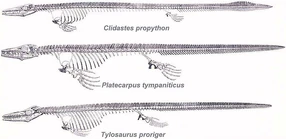
Skeletal drawings of three types of mosasaur.
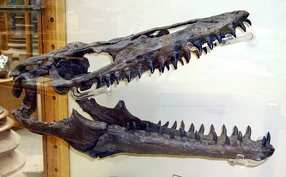
Plioplatecarpus primaevus skull, Oxford University Museum of Natural History.
Mosasaurs breathed air and were powerful swimmers that were well-adapted to living in the warm, shallow epicontinental seas prevalent during the Late Cretaceous Period. Mosasaurs were so well adapted to this environment that they gave birth to live young, rather than return to the shore to lay eggs, as sea turtles do.
The smallest-known mosasaur was Carinodens belgicus, which was about 3.0 to 3.5 meters long and probably lived in shallow waters near shore, cracking molluscs and sea urchins with its bulbous teeth. Larger mosasaurs were more typical: mosasaurs ranged in size up to 17 m. Hainosaurus holds the record for longest mosasaur, at 17.5 meters.
Mosasaurs had a body shape similar to that of modern-day monitor lizards (varanids), but were more elongated and streamlined for swimming. Their limb bones were reduced in length and their paddles were formed by webbing between their elongated digit-bones. Their tails were broad and supplied the locomotive power. This method of locomotion may have been similar to that used by the conger eel or sea snakes today. The animal may have lurked and pounced rapidly and powerfully on passing prey, rather than hunting for it.
Mosasaurs had a double-hinged jaw and flexible skull (much like that of a snake), which enabled them to gulp down their prey almost whole, a snakelike habit that has helped identify the unmasticated gut contents fossilized within mosasaur skeletons. A skeleton of Tylosaurus proriger from South Dakota included remains of the diving seabird Hesperornis, a marine bony fish, a possible shark and another, smaller mosasaur (Clidastes). Mosasaur bones have also been found with shark teeth embedded in them.
Based on features such as the double row of pterygoid ("flanged") teeth on the palate, the double-hinged jaw, modified/reduced limbs and probable methods of locomotion, many researchers believe that snakes and mosasaurs may have had a common ancestor. This theory was first suggested in 1869, by Edward Drinker Cope, who coined the term "Pythonomorpha" to include them. The idea lay dormant for more than a century, before being revived in the 1990s.[3] [4]
History of discovery[]

The Mosasaurus discovered in a Maastricht limestone quarry, 1786 (contemporary engraving)

Mosasaurus sp. paddle elements.

Illustration of the first mosasaur remains discovered.
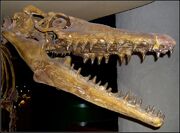
Right lateral view of the skull of the exhibit specimen of Mosasaurus hoffmanni at the Natuurhistorisch Museum Maastricht.
The first publicized discovery of a partial fossil mosasaur skull in 1764 by quarry-workers in a subterranean gallery of a limestone quarry near the Dutch city of Maastricht, preceded any major dinosaur fossil discoveries but remained little known. However, a second find of a partial skull drew the Age of Enlightenment's attention to the existence of fossilized animals that were different from any known living creatures. When the specimen was discovered between 1770 and 1774, Johann Leonard Hoffmann, a surgeon and fossil-collector, corresponded about it with the most influential scientists of his day, making the fossil famous. The original owner though was Godding, a canon of Maastricht cathedral.
Dutch naturalist Pieter Camper concluded in 1786 that the mosasaurs' remains actually belonged to a whale.[5] This debate was furthered when French scholar Faujas de Saint-Fond argued that the remains belonged to a crocodile.[5] However, in 1800 Camper's son, Adriaan, argued that the remains belonged to a giant reptile, and reported his findings to Georges Cuvier who named the fossil Mosasaurus.[5]
When the French Revolutionary forces occupied Maastricht in 1794, the carefully-hidden fossil was uncovered, after a reward, it is said, of six hundred bottles of wine, and transported to Paris. After it had been earlier interpreted as a fish, a crocodile and a sperm whale, the first to understand its lizard affinities was the Dutch scientist Adriaan Gilles Camper in 1799. In 1808 Georges Cuvier confirmed this conclusion, although le Grand Animal fossile de Maëstricht was not actually named Mosasaurus ('Meuse reptile') until 1822 and not given its full species name, Mosasaurus hoffmannii, until 1829. Several sets of mosasaur remains, that had been discovered earlier at Maastricht but were not identified as mosasaurs until the nineteenth century, have been on display in the Teylers Museum, Haarlem, procured from 1790.
The Maastricht limestone beds were rendered so famous by the Mosasaur discovery that they have given their name to the final six-million-year epoch of the Cretaceous, the Maastrichtian.
Recent events[]
In his recent book, Mulder (2003; pers. comm. 2003), reported that the first mosasaur skull, somewhat less complete than the type specimen of Mosasaurus hoffmanni (Mantell 1829), was actually discovered in 1766, near St. Pietersburg, Maastricht and is still on exhibit in the the Teylers Museum, in Haarlem (No. TM 7424). Mulder also noted that the specimen of Mosasaurus hoffmanni described above was actually found between 1770 and 1774 (not 1780), and was never actually owned by Dr. Hoffmann. According the Mulder, the Canon Godding was the first legal owner. Hoffman, however, was the person who corresponded with other scientists of the day and who got the attention of Camper and Cuvier.
Evolution:[]


Halisaurus arambourgi, a mosasaur from the Late Cretaceous of Morocco.

Hainosaurus pembinensis, aka "Bruce", from the Campanian of Canada
The most likely ancestor of mosasaurs were small terrestrial lizards called aigialosaurs that lived close to the ocean from the Late Jurassic through the Cretaceous periods. During the Middle Cretaceous, these ancestral mosasaurs became larger and more specialized, evolving rapidly into several genera of highly successful predators. By the early Coniacian, there were three major genera (Tylosaurus, Platecarpus and Clidastes) of mosasaurs that had evolved.
As mosasaurs increased in size and diversity during the last 25 million years of the Cretaceous, they also spread around the world. While their fossilized remains have been found most often in Kansas and South Dakota, their bones are known from every continent, and were most recently found in Antarctica.
Mosasaurs were not the first reptiles to take to the sea, however they were possibly the most successful. Ichthyosaurs and plesiosaurs had inhabited the oceans since the Triassic, evolving into many diverse forms and surviving several major extinction events. For unknown reasons, ichthyosaurs declined significantly in Early Cretaceous and are thought to have been extinct about the time that the earliest mosasaurs re-entered the water. Plesiosaurs were also less numerous in the Late Cretaceous than during the Jurassic, and had evolved into some very specialized forms like the long-necked elasmosaurs. Even the short-necked plesiosaurs (pliosaurs and polycotylids) were much smaller than their Jurassic cousin, Liopleurodon, and an Early Cretaceous relative, Kronosaurus. It is possible that both the ichthyosaurs and the plesiosaurs were losing the evolutionary battle of predator versus prey to faster, larger and more advanced varieties of fish such as Xiphactinus and the giant Ginsu sharks (Cretoxyrhina mantelli). Several other groups of reptiles, including marine crocodiles, teleosaurs, placodonts and turtles had also enjoyed limited successes in the marine environment, but none approached the world-wide domination that mosasaurs would attain in the Late Cretaceous.
Evolutionary antecedents[]
Based on features such as the loosely-hinged jaw, modified/reduced limbs and probable locomotion, many researchers believe that snakes share a common marine ancestry with mosasaurs, a suggestion advanced in 1869, by Edward Drinker Cope, who coined the term "Pythonomorpha" to unite them. The idea lay dormant for more than a century, to be revived in the 1990s.[3] Recently, the discovery of Najash rionegrina, a fossorial snake from South America cast doubt on the marine origin theory.
On November 16, 2005, research reported in Netherlands Journal of Geosciences confirmed that the recently uncovered Dallasaurus turneri is an early link between land-based monitor lizards (such as the Komodo dragon) and the aquatic mosasaurs.[6]
Fossils[]
Localities[]

"Ber", the type specimen of Prognathodon saturator recently acquired by the Natuurhistorisch Museum Maastricht from a nearby quarry.
Sea levels were high during the Cretaceous Period, causing marine transgressions in many parts of the world and a great inland seaway in what is now North America. Mosasaur fossils have been found in the Netherlands, in Sweden, in Africa, in Australia, in New Zealand, and on Vega Island, off the coast of Antarctica. In Canada and the United States, complete or partial specimens have been found in Alabama, Mississippi, Tennessee, and Georgia and in almost all the states covered by the seaway: Texas, southwest Arkansas, New Mexico, Kansas[7], Colorado, Nebraska, the Dakotas, Montana, Manitoba[8], and the Pierre Shale and Fox Hills formations of North Dakota.[9] Mosasaurs are also known from California, Mexico, Peru and Denmark.
Many of the 'dinosaur' remains found on New Zealand are actually mosasaurs and plesiosaurs, another group of Mesozoic predatory marine reptiles.
New evidence, including sharks' teeth embedded in partially digested mosasaur bones, from the late Coniacian Smoky Hill Chalk of Kansas indicates that mosasaurs were frequently fed upon by the large ginsu sharks (Cretoxyrhina mantelli). While it is not possible at this point to determine whether this feeding activity was the result of an attack on a live mosasaur or the scavenging of a carcass, it is probable that a five or six meter Ginsu would behave much like a modern Great White shark, or an extinct Carcharocles megalodon.
Smoky Hill Chalk[]

Illustration of various Mosasaurs compared to humans.
The presence of the remains of young individuals in the Smoky Hill Chalk of Kansas indicates that mosasaurs were giving birth in mid-ocean, 200 miles or more from the nearest land. It also suggests that mosasaurs, out of necessity, may have lived together in groups for the protection of their young. There were too many other hungry predators around, including 20 foot long sharks, giant predatory fish (Xiphactinus) and other species of mosasaurs, for young mosasaurs to have survived long without some assistance. While it is possible that the Western Interior Seaway had masses of floating seaweed that young animals could hide in, there is no fossil evidence to support this theory and the presence of many fast swimming predators, such as Xiphactinus, seems to argue for large areas of open, unobstructed water. One variety of primitive swordfish (Protosphyraena) had long pectoral fins that extended two to three feet outward on either side of its body, hardly a good design for efficient hunting in a kelp forest. Most other marine reptiles, including turtles, polycotylids and plesiosaurs, also moved through the water with long, outstretched limbs.
Diet[]
Mosasaurs probably fed primarily on fish, but are known to have eaten just about anything that they could swallow. A fossilized turtle, Allopleuron hoffmani was discovered in the stomach contents of a mosasaur. Mosasaur remains have also been uncovered that had healed jawbone fractures, showing that they were indiscriminate feeders.[5] The preserved stomach contents of a large tylosaur on exhibit in the Museum of Geology at the South Dakota School of Mines and Technology contains the bones of a smaller mosasaur (Clidastes), a bird (Hesperornis), a fish (Bananogmius) and possibly a shark. Fish remains were found in a specimen of Plotosaurus from California and a Tylosaurus from Kansas. The remains of a turtle are preserved in an European specimen, and the exhibit specimen of Tylosaurus proriger at the Smithsonian was discovered with a plesiosaur as its last meal. Ammonite shells have been found with what appear to be mosasaur bite marks, but there is some question as to whether or not these holes were caused by mosasaur bites or far more likely, by the attachment of limpets. A Globidens specimen found in South Dakota has the ground of remains of clams in its abdomen.
Teeth[]

The right dentary of Carinodens belgicus, a rare and unusually small mosasaur from the Netherlands.
It is important to note here that, with the exception of a few specialized and late evolving species, mosasaur jaws and teeth were used for seizing and holding of prey until it could be swallowed. Most mosasaur teeth are cone shaped and do not have the cutting edges typical of shark or theropod teeth. Short of dismembering its prey by the sheer force of its bite, a mosasaur had to swallow whatever it caught whole, much like a modern snake. Mosasaurs and snakes are also similar in the way that their skulls are constructed, including a lower jaw with a flexible joint that was used to ‘ratchet’ prey into the mosasaur’s throat with the aid of an additional, double row of teeth in the roof of their mouth. Living in mid-ocean, such adaptations were necessary for survival. Only a few of the later genera of mosasaurs developed specialized teeth for cutting or tearing flesh (Leiodon), or for crushing clams and other hard shelled invertebrates (Globidens).
Taxonomy[]

Taniwhasaurus

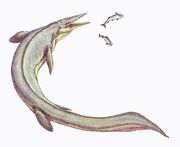
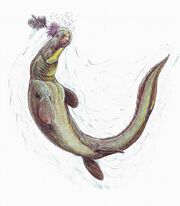
- Family Mosasauridae
- Subfamily Tylosaurinae
- Subfamily Plioplatecarpinae
- Subfamily Mosasaurinae
- Subfamily Halisaurinae
See Also[]
References[]
- ^ Michael S.Y. Lee, 1997, "The phylogeny of varanoid lizards and the affinities of snakes," in Philosophical Transactions of the Royal Society London 352 (January 1997:53-91); on-line abstract.
- ^ Squamates consist of the living varanoid lizards, snakes and their fossil relatives the mosasaurs.
- ^ a b Palaeos Vertebrates 260.100 Pythonomorpha: Pythonomorpha
- ^ Mosasaurs: Last of the Great Marine Reptiles
- ^ a b c d Dr. Palmer, Douglass. The Illustrated Encyclopedia of the Prehistoric World. 2006 Marshall Edition. Chartwell Books INC, Edison, NJ.pp. 120-121
- ^ Dallasaurus / Ancient Mosasaur - Dallasaurus - SMU
- ^ Everhart, M.J. 2005. "Enter the Mosasaurs," Chapter 9 in "Oceans of Kansas: A Natural History of the Western Interior Sea." Indiana University Press, Bloomington, 322 p.
- ^ http://www.discoverfossils.com
- ^ Getman, Myron RC. 1994. "Occurrences of Mosasaur and other reptilian fossil remains from the Fox Hills Formation (Maastrichtian: late Cretaceous) of North Dakota". St. Lawrence University Press.
External links[]
- Palaeos: Vertebrates: Mosasaurs
- BBC Science and Nature: Mosasaurs
- Mike Everhart and David Lewis, "Mesozoic marine monsters of the Mangahouanga": New Zealand fossil fauna
- Mike Everhart, "A day in the life of a Mosasaur": life in the Sea of Kansas, illus. by Carl Buell
- Mike Everhart, "Mosasaurus hoffmani" until 1829.
- Mosasaurus maximus mounted skeleton at University of Texas Memorial Museum
- Canadian Fossil Discovery Centre
- "The Mosasaur of Maastricht" by Hennie Reuvers in Crossroads web magazine